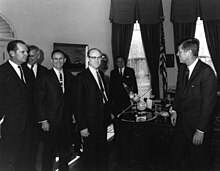 Mariner 2 engineering model | |
| Mission type | Venus flyby |
|---|---|
| Operator | NASA / JPL |
| Harvard designation | 1962 Alpha Rho 1[1] |
| COSPAR ID | 1962-041A |
| SATCAT no. | 374 |
| Mission duration | 4 months and 7 days |
| Spacecraft properties | |
| Spacecraft type | Ranger Block I |
| Manufacturer | JPL |
| Launch mass | 203.6 kilograms (449 lb)[2] |
| Power | 220 watts (at Venus encounter) |
| Start of mission | |
| Launch date | August 27, 1962, 06:53:14 UTC[1] |
| Rocket | Atlas LV-3 Agena-B |
| Launch site | Cape Canaveral LC-12 |
| End of mission | |
| Disposal | Decommissioned |
| Last contact | January 3, 1963 7:00 UTC[3] |
| Orbital parameters | |
| Reference system | Heliocentric[4] |
| Eccentricity | 0.16278 |
| Perihelion altitude | 0.720 AU (107,700,000 km; 66,900,000 mi) |
| Aphelion altitude | 1.000 AU (149,600,000 km; 93,000,000 mi) |
| Period | 292 days |
| Epoch | 14 December 1962 |
| Flyby of Venus | |
| Closest approach | 14 December 1962 |
| Distance | 34,773 km (21,607 mi) |

Mariner 2 (Mariner-Venus 1962), an American space probe to Venus, was the first robotic space probe to report successfully from a planetary encounter. The first successful spacecraft in the NASA Mariner program, it was a simplified version of the Block I spacecraft of the Ranger program and an exact copy of Mariner 1. The missions of the Mariner 1 and 2 spacecraft are sometimes known as the Mariner R missions. Original plans called for the probes to be launched on the Atlas-Centaur, but serious developmental problems with that vehicle forced a switch to the much smaller Agena B second stage. As such, the design of the Mariner R vehicles was greatly simplified. Far less instrumentation was carried than on the Soviet Venera probes of this period—for example, forgoing a TV camera—as the Atlas-Agena B had only half as much lift capacity as the Soviet 8K78 booster. The Mariner 2 spacecraft was launched from Cape Canaveral on August 27, 1962, and passed as close as 34,773 kilometers (21,607 mi) to Venus on December 14, 1962.[4]
The Mariner probe consisted of a 100 cm (39.4 in) diameter hexagonal bus, to which solar panels, instrument booms, and antennas were attached. The scientific instruments on board the Mariner spacecraft were: two radiometers (one each for the microwave and infrared portions of the spectrum), a micrometeorite sensor, a solar plasma sensor, a charged particle sensor, and a magnetometer. These instruments were designed to measure the temperature distribution on the surface of Venus and to make basic measurements of Venus' atmosphere.
The primary mission was to receive communications from the spacecraft in the vicinity of Venus and to perform radiometric temperature measurements of the planet. A second objective was to measure the interplanetary magnetic field and charged particle environment.[5][6]
En route to Venus, Mariner 2 measured the solar wind, a constant stream of charged particles flowing outwards from the Sun, confirming the measurements by Luna 1 in 1959. It also measured interplanetary dust, which turned out to be scarcer than predicted. In addition, Mariner 2 detected high-energy charged particles coming from the Sun, including several brief solar flares, as well as cosmic rays from outside the Solar System. As it flew by Venus on December 14, 1962, Mariner 2 scanned the planet with its pair of radiometers, revealing that Venus has cool clouds and an extremely hot surface.
- ^ a b Cite error: The named reference
LLwas invoked but never defined (see the help page). - ^ Cite error: The named reference
nasa1was invoked but never defined (see the help page). - ^ Cite error: The named reference
beyond2was invoked but never defined (see the help page). - ^ a b Cite error: The named reference
NSSDCwas invoked but never defined (see the help page). - ^ Cite error: The named reference
nasa2was invoked but never defined (see the help page). - ^ Cite error: The named reference
nasa3was invoked but never defined (see the help page).